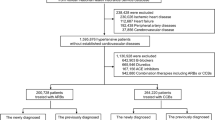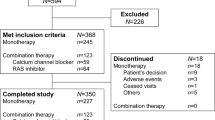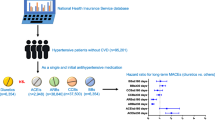Abstract
The objectives of the study were to compare long-acting dihydropyridine calcium channel blockers (CCBs) with angiotensin II receptor blockers (ARBs) according to the ambulatory blood pressure monitoring (ABPM) profile in stage 1 and 2 newly diagnosed hypertensives and also to evaluate the efficacy of high-dose monotherapy vs low-dose combination therapy of the two drug categories among the subjects with inadequate blood pressure (BP) control after conventional low-dose monotherapy. We obtained 24-h ABPM readings from 302 subjects with newly diagnosed stage 1 or 2 essential hypertension. The study protocol consisted of initial drug treatment with a low dose of either CCBs or ARBs. Hypertensives who did not achieve BP control were randomized to high-dose monotherapy of either category of drug or low-dose combination therapy. CCBs and ARBs in low-dose monotherapy achieved BP control in 53.8 and 55.3% of the cases, respectively. However, subjects under treatment with CCBs experienced side effects more often and required that treatment be discontinued. Hypertensives who failed to control their BP with low-dose monotherapy did significantly better with low-dose combination treatment (61.6%) than with high-dose CCBs (42.8%) or ARBs (40.5%) monotherapy (P<0.05). In terms of ABPM, low-dose combination therapy exhibited better 24-h BP profile according to trough-to-peak ratio, hypertensive burden and BP variability. In conclusion, low-dose ARBs and CCBs have a comparable effect in subjects with grade 1 and 2 arterial hypertension. In hypertensives who are not controlled by low-dose monotherapy, low-dose combination therapy proves be more efficacious than high-dose monotherapy.
This is a preview of subscription content, access via your institution
Access options
Subscribe to this journal
Receive 12 digital issues and online access to articles
$119.00 per year
only $9.92 per issue
Buy this article
- Purchase on Springer Link
- Instant access to full article PDF
Prices may be subject to local taxes which are calculated during checkout

Similar content being viewed by others
References
Perloff D, Sokolow M, Cowan R . The prognostic value of ambulatory blood pressure. JAMA 1983; 249: 2792–2798.
Ohkubo T et al. Prediction of mortality by ambulatory blood pressure monitoring versus screening blood pressure measurements: a pilot study in Ohasama. J Hypertens 1997; 15: 357–364.
Staessen JA et al. Predicting cardiovascular risk using conventional versus ambulatory blood pressure in older patients with systolic hypertension. JAMA 1999; 282: 539–546.
Mancia G et al. Ambulatory blood pressure normality: results from the Pamela study. J Hypertens 1995; 13: 1377–1390.
World Health Organization/International Society of Hypertension. Guideline for the management of hypertension. J Hypertens 1999; 17: 151–183.
Joint National Committee. The Sixth Report of the Joint National Committee on detection, evaluation and treatment of high blood pressure (JNC 6). Arch Intern Med 1997; 157: 2413–2446.
Joint National Committee. The Seventh Report of the Joint National Committee on detection, evaluation and treatment of high blood pressure (JNC 7). Hypertension 2003; 42: 1206–1252.
Association for the Advancement of Medical Instrumentation. American national standards for electronic and automated sphygmomanometers. AAMI, Washington, DC, 1987.
Omboni S et al. Reproducibility and clinical value of the trough-to-peak ratio of the antihypertensive effect. Evidence from the Sample Study. Hypertension 1998; 32: 424–429.
Messerli FH . ……and losartan was no better than placebo. Editorial. J Hum Hypertens 1999; 13: 649–650.
Freytag F et al. Comparison of 26-week efficacy and tolerability of telmisartan and atenolol, in combination with hydrochlorothiazide as required, in the treatment of mild to moderate hypertension: randomized multicenter study. Clin Ther 2001; 23: 108–123.
Neutel JM et al. Comparison of telmisartan with lisinopril in patients with mild to moderate hypertension. Am J Ther 1999; 6: 161–166.
Hanson L, Hedner T, Dahlof B . Prospective randomized open blinded endpoint (PROBE) study. A novel design of intervention trials. Blood Press 1992; 1: 113–119.
Smith DH et al. Prospective, randomized, open-label, blined-endpoint (PROBE) designed trials yield the same results as double-blind, placebo controlled trials with respect to ABPM measurements. J Hypertens 2003; 21: 1291–1298.
Acknowledgements
This work was supported by AstraZeneca Pharmaceutical Co, Greece.
Author information
Authors and Affiliations
Corresponding author
Rights and permissions
About this article
Cite this article
Andreadis, E., Tsourous, G., Marakomichelakis, G. et al. High-dose monotherapy vs low-dose combination therapy of calcium channel blockers and angiotensin receptor blockers in mild to moderate hypertension. J Hum Hypertens 19, 491–496 (2005). https://doi.org/10.1038/sj.jhh.1001843
Received:
Revised:
Accepted:
Published:
Issue Date:
DOI: https://doi.org/10.1038/sj.jhh.1001843



